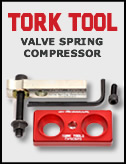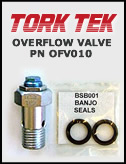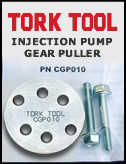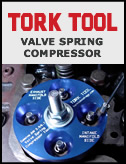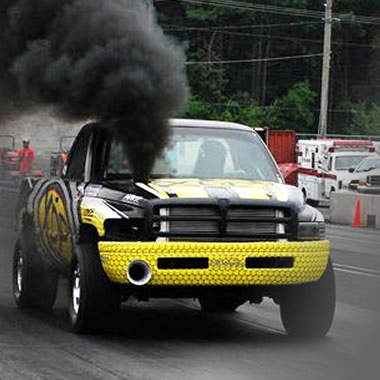- Home
- Installation Instructions for the Tork Tek Adjustable Overflow Valve
Installation Instructions for the Tork Tek Adjustable Overflow Valve
Installation Instructions for Tork Tek Adjustable Overflow Valves OFV010 & OFV020
The overflow valve is located on the back side (facing the engine) of the P7100 injection pump. The pump is located in the top-forward area of the drivers side of engine. Look for 6 injection lines on top of the pump. The valve is hidden behind the upper radiator hose. A steel return tube and banjo fitting are attached to the overflow valve. The return tube is facing down.
Clean around the valve and banjo tube assembly with a clean shop towel and gently blow off any loose particles with compressed air. Be sure to wear safety glasses.
Using a 3/4” or 19MM wrench, loosen and remove the old valve from the injection pump. In order to remove valve, gently lift the banjo fitting upwards and back, just enough to remove valve. Make sure you remove the old banjo seal washer from the back side of fitting. Discard old seals.
Cardinal rule in hydraulics. Never install a seal dry. Coat the new BS14MM seals with hydraulic or engine oil. The oil helps to make a better seal and prevents the rubber coated seal from tearing. Install one seal on the valve. Hold one seal behind the overflow valve as you screw the new valve into place. Torque to 24 ft. lbs. Do not over tighten as you can strip the threads in the injection pump.
The fuel pressure is preset from the factory to match the OEM spec (29 TO 32 psi). The pressure is adjustable from 15 to 34 PSI on the standard valve. This will allow you to tune the fuel pressure to your engine and requirements. If you want to check your fuel pressure, I strongly recommend purchasing a Tork Tek® Snubber. PN CBS010. Our snubber replaces the banjo bolt on the fuel feed line of the injection pump. The CBS010 snubber features an 1/8” NPTF port (for pressure gauge) and a micro-calibrated hole inside. This orifice will prevent your pressure gauge from wild needle movements. (which will destroy the gauge quickly) The rapid oscillations of the gauge are caused by the lift pump, which is nothing more than a piston pump.
For testing, run a 30” to 36” length of ¼” fuel rated hose from the snubber to a gauge. If you choose to supply your own testing gauge, make sure the gauge has an orifice in the base of the NPT threads or is glycerin filled. This step is for testing purposes ONLY. It is not a permanent installation. For permanent installations to an in-cab gauge, DO NOT run a hose directly to gauge. (Fire Hazard) Use one #4 SS braided fuel line to a fuel isolator (Tork Tek® PN FPI001) and one to gauge.
Start the engine and check for fuel leaks. Generally, it is not necessary to prime the fuel system when replacing the overflow valve. If the engine fails to start, pump the priming plunger on the lift pump until you hear a faint squeak from the overflow valve. That noise is fuel passing through the valve.
To adjust the valve, loosen jam nut, and adjust plunger with a 5/16” wrench. At full limit, hex plunger will bottom out in valve. Tighten jam nut with 9/16” wrench when adjusting is done. Remove the test gauge and hose after adjusting fuel pressure. Plug the snubber with a 1/8” pipe plug (provided). Installation is complete. Save instructions for future reference.
Troubleshooting:
Low fuel pressure. (1) I purposely did not change my fuel filter for 2 years. Just by changing to a new filter, pressure rose by 9 pounds. Change fuel filter. (2) Air is getting into system. The fuel heater that is located to the front of the lift pump is notorious for cracked housings. The heat from the grid element heats the electrical terminals of the heater and melts the housing. Test by removing the heater with a 5/16” Allen wrench, carefully placing it in a vise with the terminal side up. Fill terminal cavity with diesel fuel. If the fluid level drops, you have a bad heater. In Michigan, I run my truck without a fuel heater. (mine was cracked) Just install cover without the fuel heater and adapter (3) Lift pump is bad. (4) Badly rusted inlet tube on sending unit. (located on top of fuel tank) This is a common problem.
Here is a slick method to check for air leaks. You will have to buy one 14MM and one 12MM banjo fitting. They are on Ebay rather cheap. Buy the ones with a female 1/4" pipe thread. Screw in a hardware store hose barb into each fitting. Install one on the fuel filter and one on the inlet of the Bosch P7100 injection pump. Run clear vinyl hose between the fittings. Use hose clamps. Prime system and start engine. Engine will run rough for a minute or two. Watch for air bubbles in the hose. If you see bubbles, your engine will have low power and run rough. Air in the system will cause all sorts of problems. See troubleshooting above for causes.
NOTE: Set the fuel pressure to OEM specs. 17 to 22 PSI at idle. Our valve typically idles at 25 to 26 PSI. Pressure at 2500 NO LOAD RPM is 29 to 32 PSI. Tork Teknology is not responsible for injection pump leakage or damage from running excessive fuel pressure or the use of a HP overflow valve.
 Loading... Please wait...
Loading... Please wait...


